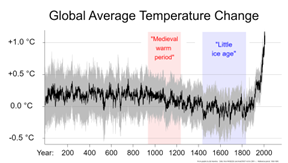Pollution is a Global Emergency
Awareness Concerning Worldwide Pollution and its Adverse Environmental Effects
The image above depicts a poster from Sabrina Bate’s classroom with the statement, “The decision isn’t Black and White,” implying environmental issues have multiple causes and multiple effects.
The issue of pollution has become a growing concern ever since the industrial revolution. Pollution, whether air, water, or land, has been found to cause many damaging effects on the environment and people. Pollution is formally defined as “the introduction of harmful materials into the environment,” These “harmful materials” are known as pollutants. Many factors contribute to pollution, but some common causes include pesticides, trash, nitrogen-based fertilizers, industrialization, and forest fires. In recent years, the discussion of pollution and its impacts has become more prevalent locally and globally. Specifically, the impacts of pollution in low-income countries and highly populated cities have gained attention. As the global population and demand for resources grow, so does the research for potential solutions to solving this crisis.
According to the Environmental Protection Association (EPA), the average American will produce 4.40 pounds of waste daily. An American individual creates about 1,606 pounds of waste in just a year. This is due to people’s reliance on fossil fuels, most of which fuel our transportation and agricultural processes.
Air pollution comes from indoor and outdoor environments and stems from pollutants such as motor vehicles, electronic devices, and factories. Additionally, volcano eruptions contribute to air pollution because volcano ash and gas are released into the environment and trapped in the atmosphere once they erupt. Some prominent air pollutants include CO, NO, O₃, and SO. Regarding water pollution, the main causes are chemicals, trash, and bacteria. However, despite being in different environments, air pollution can have an impact on water pollution. Water pollution can attract bacteria and parasites into local sewages which can contaminate areas of drinking water. This type of pollution can lead to digestive problems, neurological issues, cancer, and even death. Additionally, the practice of mining and drilling can cause oil spills, further contributing to water pollution. Lastly, regarding land pollution, the main contributors are known to be any form of urbanization, agriculture, and plastic. These pollutants can lead to polluted soils, migration, extinction, and cancer.
All three of these types of pollution are seen on a global scale The top countries with the most pollution include Bangladesh (76.9 µg/m³), Chad (75.9 µg/m³), Pakistan (66.8 µg/m³), Tajikistan (59.4 µg/m³), and India (58.1 µg/m³). In Bangladesh, studies have found that these rising pollution concerns have affected life expectancy as a whole. The average life expectancy in Bangladesh has now decreased by 6.7 years and, in some areas, has decreased by 8.1 years. Furthermore, air pollution in Bangladesh has increased by 39 percent since the year 1998 and has been estimated to cause 6.67 million deaths. Even the cleanest city in Bangladesh, Sylhet Divison, is known to have high pollution levels. In Chad, pollution has been found to cause 14,300 deaths since 2017 and is the third leading cause of premature death. These high pollution levels involve using biomass, like wood, as a main energy resource, along with waste burning- a common practice. Additionally, with the rise of transportation, there have been increased nitrogen and COemissions, two major contributors to greenhouse gas emissions. On a worldwide scale, low-income countries are disproportionately affected due to the lack of funding for innovative technology and infrastructure, hence facing the brunt of the pollution issue itself. Moreover, developing countries tend to have larger populations to sustain their economies, and as areas become increasingly populated, pollution increases likewise.
Locally, pollution issues are a growing concern as well and are primarily impacting cities. In places like New York City, vehicle traffic, industrial businesses, plastic pollution, and sewage overflows have contributed to poor air quality due to high levels of particulate matter. Specifically, during the summers and winters, that is when there is the most pollution because the sunshine contributes to higher ozone levels, and NO, SO, and CO are in abundance. Similarly, Philadelphia has high levels of pollution. The city of brotherly love is the sixth most populated city in the United States and has worsening air quality by the year. This has much to do with the mass usage of transportation and particle pollution known as black carbon. Within both cities, increased pollution has increased the prevalence of health issues like lung irritation, chest pain, and coughing.
In a recent interview with Sabrina Bates, the AP Environmental Science teacher at Pennridge High School, she was asked why students should learn about pollution. Bates highlighted that “We all are going to be consumers one day” and further discussed how it’s good to be knowledgeable about the life cycle of products and the effect an individual leaves. Bates further discussed different types of air pollutants and stated that the worst type of pollutant is plastics, as “the plastics never go away.” Heidi Neuman, a social studies teacher at Pennridge High School, expressed similar concerns to Bates. Neuman believes the younger generation should learn about pollution as we’re at a “turning point with the environment” and must begin changing our habits. Neuman described our current society as “Such a throwaway society,” always wanting something new, which in turn negatively affects mother nature.
This current ecological devastation wrought by human negligence is a global obstacle we need to take greater steps to combat. As pollution increases, so do its detrimental consequences on the environment and health. Introducing potential solutions like energy conservation and alternate uses of transportation such as walking or biking could help to decrease our pollutant usage and, in turn, decrease our emission rates. Pollution is not a disaster for one person or one country to fix but a catastrophe that every person in this world needs to take action against.
Sources:
Wikipedia, https://www.iamat.org/country/chad/risk/air-pollution. Accessed 27 February 2023.
Wikipedia, https://www.who.int/quantifying_ehimpacts/national/countryprofile/en/#T. Accessed 27 February 2023.
Wikipedia, https://www4.unfccc.int/sites/submissions/INDC/Published%20Documents/Chad/1/INDC%20Chad_Official%20version_English.pdf. Accessed 27 February 2023.
“Actions You Can Take to Reduce Air Pollution | Ground-level Ozone | New England | US EPA.” Environmental Protection Agency, 18 January 2023, https://www3.epa.gov/region1/airquality/reducepollution.html. Accessed 27 February 2023.
“Air pollution.” World Health Organization (WHO), https://www.who.int/health-topics/air-pollution#tab=tab_1. Accessed 27 February 2023.
“Air Quality Policies in Chad | UNEP.” UN Environment Programme, https://www.unep.org/resources/policy-and-strategy/air-quality-policies-chad. Accessed 27 February 2023.
Ansari, Ramiz. “Environmental issues in Pakistan.” Wikipedia, https://en.wikipedia.org/wiki/Environmental_issues_in_Pakistan. Accessed 27 February 2023.
“Bangladesh.” AQLI, https://aqli.epic.uchicago.edu/country-spotlight/bangladesh/. Accessed 27 February 2023.
“Breathing Heavy : New Evidence on Air Pollution and Health in Bangladesh (English).” World Bank Documents, https://documents.worldbank.org/en/publication/documents-reports/documentdetail/099440011162223258/p16890102a72ac03b0bcb00ad18c4acbb10. Accessed 27 February 2023.
“Environmental Issues in Pakistan and Tips to Solve Them.” Zameen.com, https://www.zameen.com/blog/tips-solve-environmental-issues-pakistan.html. Accessed 27 February 2023.
“Environmental issues in Tajikistan.” Wikipedia, https://en.wikipedia.org/wiki/Environmental_issues_in_Tajikistan. Accessed 27 February 2023.
Finley, Dennis, and Rachel Carson. “Pollution.” National Geographic Society, 14 December 2022, https://education.nationalgeographic.org/resource/pollution/. Accessed 27 February 2023.
“14,300 deaths 2 years and 11 months’ loss in life expectancy 66 µg/m3.” State of Global Air, https://www.stateofglobalair.org/sites/default/files/2019-09/soga_fact_sheet_chad_20190827_v02.pdf. Accessed 27 February 2023.
“High Air Pollution Level is Creating Physical and Mental Health Hazards in Bangladesh: World Bank.” World Bank Group, 4 December 2022, https://www.worldbank.org/en/news/press-release/2022/12/03/high-air-pollution-level-is-creating-physical-and-mental-health-hazards-in-bangladesh-world-bank. Accessed 27 February 2023.
“India Air Quality Index (AQI) and Air Pollution information.” IQAir, 29 January 2023, https://www.iqair.com/us/india. Accessed 27 February 2023.
Khan, Misha. “Environmental Issues in Pakistan.” Graana.com, 24 March 2022, https://www.graana.com/blog/environmental-issues-in-pakistan/. Accessed 27 February 2023.
“Lake Chad, a living example of the devastation climate change is wreaking on Africa.” African Development Bank, https://www.afdb.org/pt/news-and-events/lake-chad-a-living-example-of-the-devastation-climate-change-is-wreaking-on-africa-15129. Accessed 27 February 2023.
“New York City Air Quality Index (AQI) and New York Air Pollution.” IQAir, 28 January 2023, https://www.iqair.com/us/usa/new-york/new-york-city. Accessed 27 February 2023.
“Pakistan.” AQLI, https://aqli.epic.uchicago.edu/country-spotlight/pakistan/. Accessed 27 February 2023.
“Philadelphia Air Quality Index (AQI) and Pennsylvania Air Pollution.” IQAir, 31 January 2023, https://www.iqair.com/us/usa/pennsylvania/philadelphia. Accessed 27 February 2023.
“Pollution.” World Bank Group, https://www.worldbank.org/en/topic/pollution#1. Accessed 27 February 2023.
Singh, Divya. “10 Best Ways to Reduce Air Pollution & Live With Clean Air.” AQI, 8 September 2017, https://www.aqi.in/blog/10-best-ways-to-reduce-air-pollution/. Accessed 27 February 2023.
“Tajikistan – Environmental Problems.” Country Studies, https://countrystudies.us/tajikistan/16.htm. Accessed 27 February 2023.
“Tajikistan – Environmental Problems.” Country Studies, https://countrystudies.us/tajikistan/16.htm. Accessed 27 February 2023.
“10 Solutions to Combat Water Pollution.” Atlas Scientific, https://atlas-scientific.com/blog/water-pollution-solutions/. Accessed 27 February 2023.
“Water Pollution | EHEP | Harvard T.H. Chan School of Public Health.” Harvard T.H. Chan School of Public Health, https://www.hsph.harvard.edu/ehep/82-2. Accessed 27 February 2023.
“Water Pollution | EHEP | Harvard T.H. Chan School of Public Health.” Harvard T.H. Chan School of Public Health, https://www.hsph.harvard.edu/ehep/82-2. Accessed 27 February 2023.
“The World’s Most and Least Polluted Countries.” U-Earth, 22 August 2022, https://www.u-earth.eu/post/world-most-least-polluted-countries. Accessed 27 February 2023.
Ruiz, Angelina. “The Trash One Person Produces in One Year.” Waste Advantage Magazine, 23 Nov. 2018, https://wasteadvantagemag.com/the-trash-one-person-produces-in-one-year/#:~:text=How%20much%20trash%20does%20the,That’s%20a%20lot!
Isabella White, Grade 12. Interests/hobbies include Mini-THON, buildOn, Key Club, NHS, Student Council, working two jobs, hanging out with friends and...













